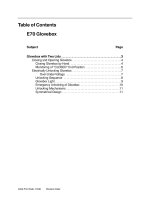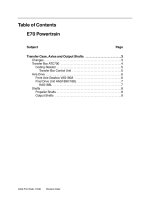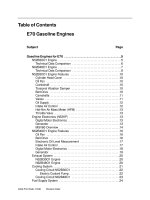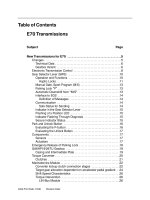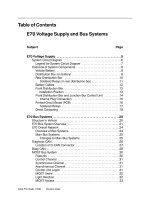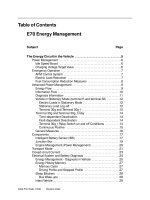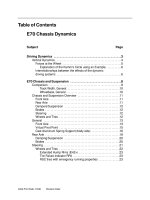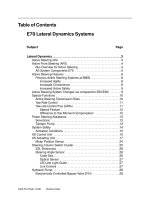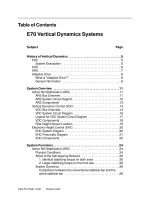Xe ô tô BMW X5 E70 SM 04d_E70 Longitudinal Dynamics Systems
Bạn đang xem bản rút gọn của tài liệu. Xem và tải ngay bản đầy đủ của tài liệu tại đây (795.01 KB, 44 trang )
Initial P
rint
Dat
e: 10/06
Table of Contents
Subject Page
Introduction . . . . . . . . . . . . . . . . . . . . . . . . . . . . . . . . . . . . . . . . . . . . . . . . . .5
Longitudinal Dynamics Systems . . . . . . . . . . . . . . . . . . . . . . . . . . . . . . . . . .5
ABS in DSC . . . . . . . . . . . . . . . . . . . . . . . . . . . . . . . . . . . . . . . . . . . . . . . . .5
Dynamic Stability Control (DSC) . . . . . . . . . . . . . . . . . . . . . . . . . . . . . . .6
Electromechanical Parking Brake (EMF) . . . . . . . . . . . . . . . . . . . . . . . .6
Dynamic Cruise Control (DCC) . . . . . . . . . . . . . . . . . . . . . . . . . . . . . . . .6
New Features of the DSC E7x . . . . . . . . . . . . . . . . . . . . . . . . . . . . . . . . . .12
Classic Brake Control Functions . . . . . . . . . . . . . . . . . . . . . . . . . . . . . . . . .13
Additional Brake Control Functions . . . . . . . . . . . . . . . . . . . . . . . . . . . . . .14
Basic Functions of the EMF . . . . . . . . . . . . . . . . . . . . . . . . . . . . . . . . . . .16
Emergency Release . . . . . . . . . . . . . . . . . . . . . . . . . . . . . . . . . . . . . . . . . . .16
Restoring Operation After Emergency Release . . . . . . . . . . . . . . . . .16
Service Functions . . . . . . . . . . . . . . . . . . . . . . . . . . . . . . . . . . . . . . . . . . . . .17
Example Scenarios . . . . . . . . . . . . . . . . . . . . . . . . . . . . . . . . . . . . . . . . . . . .17
Transition from EMF Actuating Unit to DSC . . . . . . . . . . . . . . . . . . . .17
Transition from DSC to EMF Actuating Unit . . . . . . . . . . . . . . . . . . . .18
Function of the Parking Brake Controlled by the DSC Hydraulics . . . .18
Scenario: "Engine running" . . . . . . . . . . . . . . . . . . . . . . . . . . . . . . . . . .18
Scenario: "At rest" . . . . . . . . . . . . . . . . . . . . . . . . . . . . . . . . . . . . . . . . . .18
Dynamic Braking . . . . . . . . . . . . . . . . . . . . . . . . . . . . . . . . . . . . . . . . . . . . . .18
Exiting Dynamic Emergency Braking . . . . . . . . . . . . . . . . . . . . . . . . . .19
Error Messages . . . . . . . . . . . . . . . . . . . . . . . . . . . . . . . . . . . . . . . . . . . . . . .20
General Parking Brake Fault Concept . . . . . . . . . . . . . . . . . . . . . . . . . . . .20
Fault Distribution Between DSC and EMF Control Unit . . . . . . . . . .20
Fault Regeneration . . . . . . . . . . . . . . . . . . . . . . . . . . . . . . . . . . . . . . . . . .21
Monitoring and Fault Detection . . . . . . . . . . . . . . . . . . . . . . . . . . . . . . .22
System Components. . . . . . . . . . . . . . . . . . . . . . . . . . . . . . . . . . . . . . . . .23
Hydraulic Unit with Add-on Control . . . . . . . . . . . . . . . . . . . . . . . . . . . . .23
DSC Control Unit . . . . . . . . . . . . . . . . . . . . . . . . . . . . . . . . . . . . . . . . . . .23
Wheel Speed Sensor . . . . . . . . . . . . . . . . . . . . . . . . . . . . . . . . . . . . . . . . . .28
Steering Column Switch Cluster . . . . . . . . . . . . . . . . . . . . . . . . . . . . . . . .30
SZL Electronics . . . . . . . . . . . . . . . . . . . . . . . . . . . . . . . . . . . . . . . . . . . . .31
Steering Angle Sensor
. . . . . . . . . . . . . . . . . . . . . . . . . . . . . . . . . . . . . . . . .31
Code Disc . . . . . . . . . . . . . . . . . . . . . . . . . . . . . . . . . . . . . . . . . . . . . . . . .31
E70 Longitudinal Dynamics Systems
R
e
vision Dat
e:
Subject Page
Optical Sensor . . . . . . . . . . . . . . . . . . . . . . . . . . . . . . . . . . . . . . . . . . . . .32
Line Camera . . . . . . . . . . . . . . . . . . . . . . . . . . . . . . . . . . . . . . . . . . . . . . .32
DSC Sensor . . . . . . . . . . . . . . . . . . . . . . . . . . . . . . . . . . . . . . . . . . . . . . . . . .33
Electromechanical Parking Brake (EMF) . . . . . . . . . . . . . . . . . . . . . . . . . .34
EMF Button . . . . . . . . . . . . . . . . . . . . . . . . . . . . . . . . . . . . . . . . . . . . . . . .34
Emergency Release . . . . . . . . . . . . . . . . . . . . . . . . . . . . . . . . . . . . . . . .35
Using the E70 EMF Emergency Release . . . . . . . . . . . . . . . . . . .36
Electromechanical Actuating Unit . . . . . . . . . . . . . . . . . . . . . . . . . . . .37
EMF Actuating Unit Opened . . . . . . . . . . . . . . . . . . . . . . . . . . . . . .38
Force Sensor . . . . . . . . . . . . . . . . . . . . . . . . . . . . . . . . . . . . . . . . . . . .39
Cruise Control with Brake Intervention (DCC) . . . . . . . . . . . . . . . . . .40
Service Information . . . . . . . . . . . . . . . . . . . . . . . . . . . . . . . . . . . . . . . . . .42
Adjusting the Brake Shoes . . . . . . . . . . . . . . . . . . . . . . . . . . . . . . . . . . . . .42
Removing the Bowden Cable Assemblies . . . . . . . . . . . . . . . . . . . . . . . .42
Start-up . . . . . . . . . . . . . . . . . . . . . . . . . . . . . . . . . . . . . . . . . . . . . . . . . . . . . .43
Initializing the Parking Brake . . . . . . . . . . . . . . . . . . . . . . . . . . . . . . . . . . . .43
Bedding in the Duo-servo Brake . . . . . . . . . . . . . . . . . . . . . . . . . . . . . . . .43
Function on Brake Rolling Dynamometer . . . . . . . . . . . . . . . . . . . . . . . . .44
Subject Page
BLANK
PAGE
4
E70 Longitudinal Dynamics Systems
Longitudinal Dynamics Systems
Model: E70
Production: From Start of Production
After completion of this module you will be able to:
• Understand the integration of ABS, DSC, EMF and DCC in Longitudinal
Dynamics System.
• Describe the operation of Longitudinal Dynamics System.
• Identify the components that operate Longitudinal Dynamics System.
Longitudinal Dynamics Systems
By applying today's standard consideration aspects, subdividing the functions of driving
dynamics systems into the three co-ordinate axes results in the use of three different
systems that belong to longitudinal dynamics on the E70.
Longitudinal dynamics systems (effective direction mainly on the x-axis or longitudinal
axis):
• (ABS) Anti-lock braking system
• (DSC) Dynamic stability control
• (EMF) Electromechanical parking brake
• (DCC) Dynamic cruise control (cruise control with brake intervention)
ABS in DSC
The ABS prevents the wheels locking while braking and therefore ensures that the vehi-
cle stays on track and can be steered in critical situations.
ABS is constantly activated during vehicle operation and cannot be switched off by the
driver. The four wheel speed sensors send data to the DSC control unit that monitors the
speed of each wheel. If one or several wheels decelerate at a faster rate than permitted,
the DSC control unit activates the hydraulic unit, which in turn reduces the hydraulic
pressure in the corresponding brake line. The DSC control unit and the hydraulic unit
make up one assembly.
When the DSC control unit requests intervention of the antilock braking system, it acti-
vates the inlet and outlet solenoid valves in the hydraulic unit of the affected brake line
and switches on the return pump. The inlet valve closes in order to disconnect the brake
line(s) from the master brake cylinder and the outlet valve opens to allow the brake fluid
of the affected brake circuit to escape into the reservoir in order to reduce the pressure in
the circuit. Consequently, the braking effect is reduced and the wheel begins to turn.
The DSC control unit then opens and closes the inlet and outlet valves in such a way as
to ensure the optimum braking pressure is built up at each wheel without the wheels
locking.
The return pump conveys brake fluid from the equalizing reservoir of the master
brake cylinder, thus maintaining a constant brake fluid pressure downstream of the inlet
valves so that the pressure in the brake lines is immediately re-established when the inlet
valves are open again.
In the case of braking with ABS assistance, the driver normally obtains feedback in the
form of pedal vibration and the noise of solenoid valves or the pump. This is reduced to a
minimum by the high-performance hydraulic unit of the DSC E7x in the E70.
5
E70 Longitudinal Dynamics Systems
Introduction
Dynamic Stability Control (DSC)
The E70 is equipped with a new generation of the dynamic stability control system.
Note: To date, the DSC driving dynamics system on all-wheel drive vehicles
was referred to with the abbreviation "DXC".
Since this lead to confusion with the xDrive, in the future the dynamic stability control sys-
tem will be known as DSC also on all-wheel drive vehicles.
This new generation of the dynamic stability control (DSC E7x, supplied by Bosch) in the
BMW X5 is actually the only driving dynamics system that covers all three areas of longi-
tudinal, transverse and vertical dynamics with its control intervention functions and its
modular functional structure.
With its varied control strategies, the DSC ensures outstanding driving stability within
physical limits, active safety and excellent traction in all driving situations.
Electromechanical Parking Brake (EMF)
The electromechanical parking brake was used for the first time at BMW on the E65 (7
Series).
In principle, the task of the parking brake is to secure the stationary vehicle to prevent it
rolling away. The parking brake firmly holds the parked vehicle. In contrast to the parking
brake that to date was based on a pure mechanical hand brake and foot brake system,
the EMF is designed as an automated, comfort-oriented parking brake system where the
driver can apply and release the parking brake by the push of a button.
The design layout of the parking brake system is in keeping with typical BMW require-
ments:
• Exclusion of all safety-critical situations
• Optimum functionality
• Maximum system availability
• High degree of comfort and convenience
Besides complying with the legal requirement of mechanically holding the parked vehicle
and providing an independently operable parking brake in addition to the service brake,
one of
the main adv
antages of
the EMF is that it enables dynamic braking with DSC con-
trol.
Dynamic Cruise Control (DCC)
The dynamic cruise control is a conventional cruise control system (Tempomat) which
features additional functions including active brake intervention. Cruise control with brake
intervention (DCC) was introduced for the first time at BMW on the E90 (3 Series).
6
E70 Longitudinal Dynamics Systems
7
E70 Longitudinal Dynamics Systems
Bus Overview DSC
Index Explanation Index Explanation
CAS
Car Access System
DSC
Dynamic stability control
IHKA
A
utomatic climate control
DME
Digital motor electronics
KOMBI
Instrument cluster
DDE
Digital diesel electronics
JB
Junction box
EMF
Electromechanical parking brake
DSC SEN
DSC sensor
V
GSG
T
ransfer box control unit
SZL
Steering column switch cluster
GWS
Gear selector lever
8
E70 Longitudinal Dynamics Systems
D
SC Circuit Diagram
L
egend for DSC Circuit Diagram
DSC System Overview
9
E70 Longitudinal Dynamics Systems
Index Explanation Index Explanation
1
Wheel-speed sensor, front left
11
Brake light switch
2
Brake pad wear indicator, front left
12
Instrument cluster
3
Brake fluid level sensor
13
Center console switch cluster
4
Digital motor electronics
14
Automatic climate control
5
Dynamic stability control
15
Gear selector lever
6
Wheel-speed sensor, front right
16
DSC sensor
7
Junction-box ECU
17
Transfer box control unit
8
Wheel-speed sensor, rear right
18
Steering column switch cluster
9
Brake pad wear indicator, rear right
19
Car Access System
10
Wheel speed sensor, rear left
Index Explanation Index Explanation
1
Hy
dr
aulic unit with DSC control unit
5
Cent
er
console switch cluster
2
Wheel speed sensor (4x)
6
Steering column switch cluster
3
Master brake cylinder
7
Gear selector lever
4
DSC sensor
8
EMF actuating unit
10
E70 Longitudinal Dynamics Systems
E
MF Schematic Circuit Diagram
L
egend for EMF Schematic Circuit Diagram
EMF System Overview
11
E70 Longitudinal Dynamics Systems
I
ndex
E
xplanation
I
ndex
E
xplanation
1
Wheel-speed sensor, front left
5
Instrument cluster
2
Dynamic stability control
6
Gear selector lever
3
Digital motor electronics
7
EMF actuating unit
4
Junction-box ECU
Index Explanation Index Explanation
1
Dynamic stability control
4
EMF actuating unit
2
Master brake cylinder
5
Emergency release EMF
3
Gear
select
or
lever
New Features of the DSC E7x
The system supplier for the DSC E7x is Bosch. With its optimized control functions, the
new system design makes a significant contribution to increased driving dynamics.
Additional functions for active safety and additional comfort have been implemented in
the new system. The new system in the E70 offers the following advantages:
• Driving Dynamics
– DSC mode: Increased driving dynamics and maximum traction. Thanks to more
precise and faster control interventions, the driver can further extend the bound-
aries of driving dynamics while retaining vehicle safety.
– DTC mode: Compared to DSC mode, Dynamic Traction Control (DTC) allows for
increased slip at the drive wheels to provide maximum propulsion when driving off
in snow for instance. In addition, the stabilizing control interventions cut in later in
DTC mode thus allowing a more sport-oriented driving profile.
• Active Safety
– The additional functions of brake standby, dry braking and fading assistance short-
en the stopping distances.
– Increased DSC efficiency makes for more effective safety-relevant functions.
• Comfort
– Improved operating comfort (brake interventions are less audible, pedal vibration is
drastically reduced) through the use of a 6-piston pump in connection with a new
higher-frequency electrical actuation system.
– Additional functions such as start-off assistant and parking brake provide increased
driver assistance and comfort.
12
E70 Longitudinal Dynamics Systems
Classic Brake Control Functions
• Antilock Braking System (ABS)
ABS prevents individual wheels from locking while braking by targeted modulation of
the braking pressures. The steerability of the vehicle through the front wheels is
largely retained. When braking on road surfaces with different coefficients of friction,
the straight-ahead position is stabilized in co-operation with the active steering
(option).
• Cornering Brake Control (CBC)
(CBC) keeps the vehicle under control when braking lightly in fast corners by asym-
metric control of the braking pressure, thus improving the cornering stability.
• Automatic Stability Control (ASC)
(ASC) prevents spinning of the drive wheels by way of specific brake application and
influencing the drive torque delivered by the combustion engine thus optimizing the
forward propulsion of the vehicle.
• Dynamic Brake Control (DBC)
If an emergency braking operation is initiated by the driver, the system assists the
driver by automatically applying the maximum braking pressure immediately in order
to optimize the braking effect.
• Automatic Differential Brake (ADB-X)
ADB-X replicates the function of the differential locks: if a wheel tends towards spin-
ning, it is automatically braked so that forward propulsion can still be achieved
through the other wheel on the axle.
• Dynamic Stability Control (DSC)
A vehicle which tends to understeer or oversteer is stabilized by specific brake inter-
vention on individual wheels. This function operates on the E70 together with the
active steering (option).
• Hill Descent Control (HDC)
HDC automatically applies the brakes at individual wheels when driving downhill at
lo
w speed, particularly on poor surfaces such as sand, gravel or snow. The function
is activated by means of a button in the center console.
• Trailer Stabilization Logic
This function automatically detects when a vehicle with a trailer begins to sway and it
stabilizes the vehicle-trailer combination by specific brake intervention thus reducing
the speed to belo
w the critical shear/swerve level.
13
E70 Longitudinal Dynamics Systems
Additional Brake Control Functions
• Dynamic Traction Control (DTC)
DTC represents a special mode of DSC which, while interacting with (ASC), (ADB-X)
and xDrive, realizes maximum propulsion on loose surfaces such as snow, sand or
gravel, by extending the slip thresholds. The stabilization interventions in connection
with DTC cut in later than with DSC thus enabling a more sport-oriented driving pro-
file.
• Brake Standby
This function builds up a moderate braking pressure in the system when the driver
very quickly takes his/her foot off the accelerator pedal. The braking effect then cuts
in faster to assist the driver in emergency braking.
• Dry Braking
This function lightly applies the brake pads at specific intervals depending on the
operation of the windscreen wiper in order to dry the brake discs. This distinctly
improves the braking effect in braking operations.
• Fading Assistance
This function assists the driver in applying the braking force when the brake temper-
ature is very high due to an extreme driving profile which requires a higher braking
force in order to achieve the required braking effect.
• Start-off Assistant
The start-off assistant holds the vehicle on gradients for about. 1.5 seconds after
the driver has taken his/her foot from the brake. In this way, the driver can conve-
niently operate the accelerator pedal without the vehicle rolling back.
• Electromechanical Parking Brake (EMF)
The EMF is a parking brake that can be applied and released by means of a bidirec-
tional button. Depending on the respective vehicle operating situation, the holding
force is applied wither hydraulically via the DSC or mechanically via EMF.
14
E70 Longitudinal Dynamics Systems
Symbols:
= System active
X = System with elevated control thresholds
= Can be switched on/o
eb naCnoitcnuF
switched
on/off by
driver
DSC ON DTC DSC OFF
ABS
EBV
CBC
MSR
ASC X
ADB-X
DSC X
HDC
Dry braking
Start assist
Braking readiness
Fading assistance
DBC
- DBS
- MBS
EMF [parking brake]
GRR+ (included in active steering option)
RPA
CBS
D
SC Functions
15
E70 Longitudinal Dynamics Systems
The parking brake (EMF) has two different functions, depending on the operating status
of the vehicle.
• Parking brake mode
– When the engine is running or the vehicle is rolling, the parking brake acts on the
service brake with the aid of the DSC hydraulics. This means the brake units on the
front and rear axle are active.
– If the engine is not running and the vehicle is stationary, the electromechanical
actuator and its cable assembly ensure the parking brake acts on the duo-servo
drum brake on the rear axle. In this case, the vehicle is braked as defined in the con-
trol unit.
• Dynamic braking
Defined retardation is triggered via the DSC system if the parking brake button is
pulled up while driving. The retardation or deceleration is monitored by the DSC
control functions and takes place for as long as the parking brake button is pulled.
Emergency Release
A mechanical emergency release facility is provided in order to be able to release the
parking brake in the event of the electromechanical actuating unit failing or insufficient
power supply.
Secure vehicle to prevent it rolling before operating
the emergency release!
The release procedure is performed manually with the emergency release cable assem-
bly and the emergency release handle from the vehicle tool kit. The emergency release
procedure releases the duo-servo drum brake by way of mechanical intervention in the
actuator of the electromechanical control unit.
Note: After a power failure, it may still not be possible to move the vehicle even
after
releasing the brake with the emergency release facility. The park-
ing lock of the automatic gearbox may still be engaged (see Product
Information Automatic Gearbox E70).
Once released, using the emergency release facility, the parking brake cannot be reacti-
vated manually. The function can be restored only by way of electrical activation.
Restoring Operation After Emergency Release
After turning on the ignition, push down the EMF operating button and pull up again to
activate the parking brake.
Basic Functions of the EMF
16
E70 Longitudinal Dynamics Systems
CAUTION!!!
Service Functions
After replacing the brake shoes of the duo servo drum brake as part of repair or mainte-
nance procedures, the new brake shoes must be bedded-in to ensure adequate holding
effect of the new brake shoes. The software of the EMF control unit features a "bedding-
in" service mode that must be activated in this case with the BMW diagnostic system.
Indicator/warning lamps in the instrument cluster signal the operating status as well as
system fault situations. In the event of faulty signals, the system causing the problem
enters corresponding fault codes in the control unit and the system is partially or totally
shut down corresponding to the situation. The driver receives additional information on
any restricted functions in the control display.
Note: It is only possible to coast or push the vehicle with the transmission in
position N. Neutral usually remains selected for a maximum of 30 min-
utes. If the vehicle is stationary for longer, the automatic transmission
parking lock will automatically be engaged.
Example Scenarios
Basic function of the parking brake controlled by the actuating unit Scenario: "Ignition
ON", the engine is not yet running and the foot brake is pressed.
With the vehicle stationary, the parking brake is released or applied by pulling or pressing
the EMF button. The indicator lamp in the instrument cluster either goes out or lights up
red.
Note: The parking brake can be released only with the foot brake pressed when
the engine is running or turned off.
The dynamic braking function is triggered if the EMF operating button is pulled while the
vehicle is rolling.
Transition from EMF Actuating Unit to DSC
The system switches over from mechanical to hydraulic mode when the engine is start-
ed. If the EMF actuating unit was applied at the time, the DSC hydraulics will assume
contr
ol of the br
aking force. The EMF actuating unit is not released until the hydraulics
are holding the vehicle secure. The indicator lamp remains lit red throughout this process,
and the driver is unaware of the transition (the lamp does not even flash).
17
E70 Longitudinal Dynamics Systems

